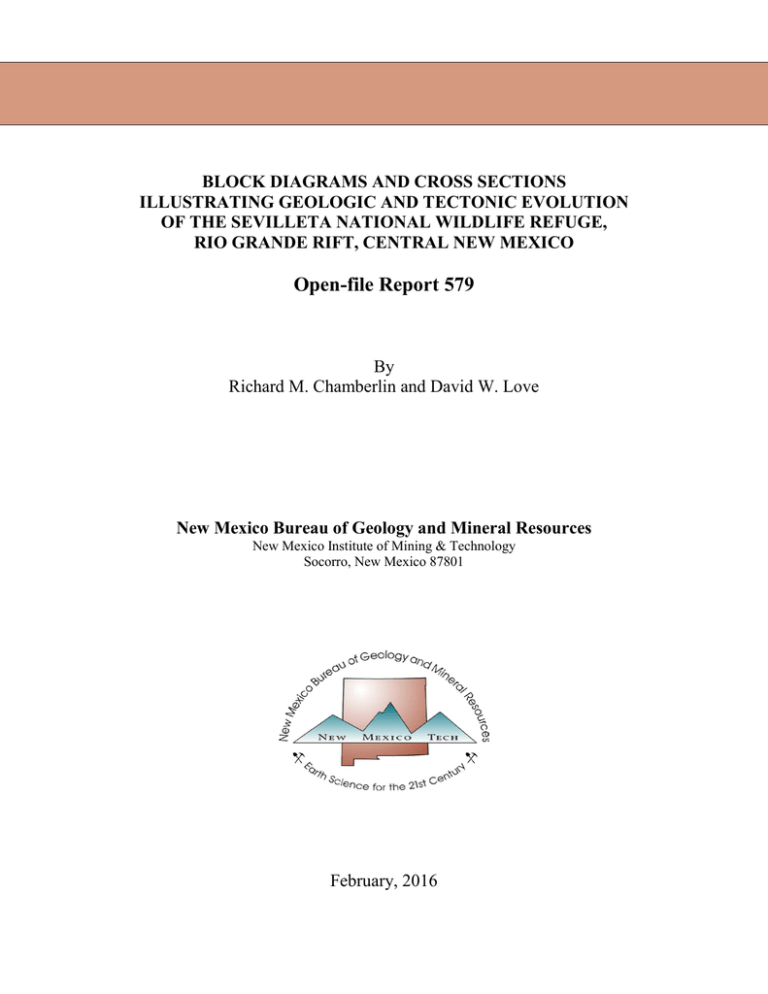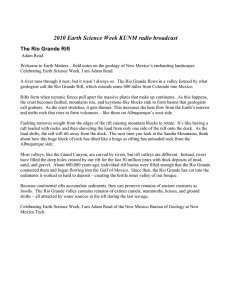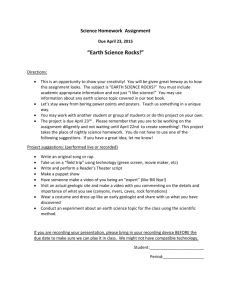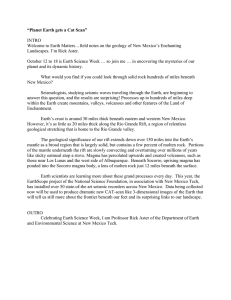Document 10915897
advertisement

BLOCK DIAGRAMS AND CROSS SECTIONS ILLUSTRATING GEOLOGIC AND TECTONIC EVOLUTION OF THE SEVILLETA NATIONAL WILDLIFE REFUGE, RIO GRANDE RIFT, CENTRAL NEW MEXICO Open-file Report 579 By Richard M. Chamberlin and David W. Love New Mexico Bureau of Geology and Mineral Resources New Mexico Institute of Mining & Technology Socorro, New Mexico 87801 February, 2016 ABSTRACT The Sevilleta National Wildlife Refuge (SNWR) lies athwart the Rio Grande rift in central New Mexico. Seven block diagrams and detailed captions are presented to illustrate the geologic and tectonic evolution of the SNWR. Diagrams represent: 1) continental accretion in the Paleo- and Meso-Proterozoic, 2) the Late Paleozoic ancestral Rocky Mountains orogeny, 3) the foreland basin of the Late Cretaceous western interior seaway, 4) the late-stage Laramide orogeny, 5) Paleogene supervolcanoes of the early Rio Grande rift, 6) early Neogene domino-style extension above a hot middle crust, and 7) late Neogene extension of the active Rio Grande rift. Additional diagrams include a perspective diagram of the SNWR, a geologically and geophysically constrained structure section across the active rift at 37º 17’ N, an annotated stratigraphic column and an index map showing the location of the SNWR within the Rio Grande rift. INTRODUCTION This report presents a series of seven block diagrams that illustrate the geologic and tectonic evolution of the Sevilleta National Wildlife Refuge (SNWR) in central New Mexico. From oldest to youngest, the block diagrams show the generalized structure of middle Proterozoic crustal accretion in central NM (Fig.1, 1660-1400 Ma), regional geometry of late Paleozoic uplifts and seaways of the Ancestral Rocky Mountains (Fig.2, 310-290 Ma), regional morphology of the late Cretaceous western interior seaway (Fig.3, 95-70 Ma), crustal shortening and basement-cored uplifts of the Laramide orogeny (Fig.4, 50-40 Ma), regional caldera-forming ignimbrite volcanism and coeval basaltic plateau eruptions associated with back-arc extension (Fig. 5, 33-25 Ma), regional domino-style upper crustal extension and early basin subsidence of the Miocene Rio Grande rift (Fig. 6, 15-10 Ma), and local high-angle horst-graben structure of the latestage Rio Grande rift and coeval influx of the ancestral Rio Grande across the SNWR (Fig. 7, 5 Ma to present). Block diagrams are accompanied by a northward looking perspective diagram of the SNWR coupled with an east-west cross section across the axial portion of the Rio Grande rift near 34º 17’ North (Fig. 8). The central portion of this geologic cross section (Fig. 9), across the actively extending rift is shown along with a high-resolution aeromagnetic profile and a regionally adjusted gravity profile that provide constraints on the subsurface geometry of relatively non-magnetic (and low density) basin fill, both of which are controlled by extensional fault blocks in the upper crust. An annotated rock stratigraphic column (Fig.10) for the SNWR also provides many additional details of geologic history for the region. The above mentioned diagrams were prepared at the request of Kathy Granillo (Refuge Manager) and Jeannine Kimble (Visitor Services Manager) of the Sevilleta National Wildlife Refuge in 2012, to be used in a geology-archaeology display at the SNWR visitor’s center. Only the perspective diagram/cross section and rock column are used in the present display. An additional diagram, presented here, shows the location of the SNWR with respect to the Rio Grande rift (Fig.11). BLOCK DIAGRAMS All of the geologic scenarios shown in the block diagrams reflect the relative motions—convergent, divergent and lateral sliding— of tectonic plates over much of earth history. Large (bold) arrows show the general direction of plate motion (tectonic transport) during the time period. All motions are relative to an arbitrary point of reference—such as R1. But R1 may also be moving relative to a second arbitrary point R2, and so on. To help visualize the relative plate motions, the diagrams are arbitrarily 2 “nailed down” on the side that was relatively immobile. For figures 4-7, this relatively “immobile plate” is the cratonic core of North America, which in New Mexico is the Great Plains physiographic province. Small half arrows indicate the relative motion of fault blocks that were active during the time period. Older inactive structures are indicated with gray arrows and red arrows indicate older structures reactivated by later plate motions. For simplicity, Proterozoic structures in the crystalline “basement” (Fig. 1) are not shown in later diagrams. However it is important to note that basement structures are commonly reactivated by later tectonic stress regimes (but often with a new sense of shear). Several block diagrams (figs. 3, 5 and 7) do show older buried structures from a previous episode of crustal deformation. The perspective block diagrams are drawn looking to the Northeast and generally illustrate the morphology and structure of the upper crust to a depth of 6-9 miles. The areas depicted across the blocks vary in size and the structure shown becomes increasingly schematic going back in time. Locations of modern-day reference points are shown schematically to provide an approximate scale. Perspective diagrams cannot be drawn to true scale. Structures shown on the lower right face (east-west face) of the blocks are drawn at approximately true scale; however the associated topography is exaggerated and the geometry of the blocks becomes increasingly uncertain with depth. Changing climates and elevations, relative to sea level, are additional aspects of the block diagrams. Rock layers shown in the block diagrams represent major periods of geologic time and commonly include several geologic formations; colors of these generalized stratigraphic units are linked to the SNWR rock column, Figure 10. 3 Block diagrams presented here are supported by published geologic maps, most of which are recently completed Open File Geologic Maps (OFGM) produced by the STATEMAP program of the New Mexico Bureau of Geology and Mineral Resources, available at https://geoinfo.nmt.edu/publications/maps/geologic/ofgm/home.cfml The block diagrams are also guided by regional syntheses of selected time periods within the geologic history of central New Mexico (e.g. Mack and Giles, 2004). 4 Figure 1. Between 1.66 and 1.4 billion years ago, all of New Mexico underwent multiple episodes of collisions of continents with mountain building, igneous intrusions and volcanoes, erosion, and thick accumulations of sediments. The top of this block as illustrated is a slice across what would have been seen when these rocks were buried approximately 10 miles down and at temperatures of 500-600 degrees Celsius (hot enough to melt some rocks and change the mineral make-up or metamorphose the rest). The block illustrates thrust faults (up-arrows and teeth), strike-slip faults (horizontal arrows on top of block), and multiple episodes of folds (bands of squiggly arcs on both sides and top of block). The 10 miles of rock was eroded away before the first Paleozoic seas approached this area about 325 million years ago. The erosion surface is known as “The Great Unconformity.” These rocks may be seen at the surface in the Los Pinos and Ladron Mountains and in the Joyita Hills. These old “basement” rocks underlie all other rocks. 5 Figure 2. Uplifts and down-dropped blocks of older rocks are flooded episodically by marine and non-marine sediments in low-lying areas. Marine environments are teaming with many invertebrate organisms with hard shells. Although other tectonic processes may have been active at this time, central New Mexico was also on the western margin of an east-west trending collision zone between South America and North America. Here large blocks of the crust were being pushed up, down, and sliding horizontally away from the collision zone (located in east-central Texas). In late Paleozoic time (325-250 million years ago) New Mexico was near the equator in a warm marine and arid coastal plain depositional environment. Late Paleozoic rock units are shown in shades of blue, Proterozoic basement rocks are gray. 6 Figure 3. Cretaceous seaway transgresses and regresses (comes and goes) across Sevilleta area, depositing marine and coastal-plain sediments, off and on, over at least 10 million years (part of the rock record is locally eroded away). Marine invertebrate fossils (~96-86 million years old) are abundant in Cretaceous rocks preserved on Sevilleta NWR. Subsidence of the “Western Interior Seaway” of Cretaceous age was contemporaneous with low-angle subduction of the Farallon plate that caused crustal shortening and mountain building west of the Colorado Plateau (e.g. Utah and Arizona). Plate convergence and mountain building along western North America loads the western portion of the continent (like a person on a diving board); this causes a continental scale downwarp under the Cretaceous seaway. Due to global warm temperatures, worldwide sea levels were also at a maximum height in Cretaceous time. Cretaceous rock units (and early Mesozoic rocks) are shown in shades of green; late Paleozoic rocks are blue and Proterozoic rocks are gray. 7 Figure 4. Continuing plate convergence and subduction at a low angle drives the relatively rigid Colorado Plateau northeastward against the cratonic core of North America (Great Plains physiographic province). The southern Rocky Mountains of the Laramide orogeny are squeezed up and over the plains, as if in the jaws of a giant vise. Crustal shortening and lateral slip (west side to the north) is accommodated by dextral thrust faults (up arrows and faults with “teeth”) and folds older rocks into lesser uplifts and basins. As uplifts erode, early Cenozoic sediments that locally contain abundant pebbles of sandstone, limestone and granitic rocks are deposited in low areas. These nonvolcanic sediments are the lowest part of the “Paleogene pink” unit on the stratigraphic chart, Fig. 10. Mesozoic rocks are green, Paleozoic rocks are blue and Proterozoic rocks are gray. 8 Figure 5. As plate convergence continues, subduction steepens and an Andean-type volcanic arc migrates into southwestern New Mexico (45-35 Ma). Volcanism transitions into large volume caldera-forming pyroclastic eruptions as the underlying subducting slab becomes progressively detached from sea-floor spreading and then begins to sink by sweeping westward (“rolling back”). Asthenospheric mantle upwells in wake of the sinking slab causing decompression melting. Many batches of basaltic magma are transported by dikes to the lower crust where they pool in sill complexes. Basaltic sill and dike complex acts as a hotplate to fuel large volume secondary melt formation in the middle and upper crust. From 33-25 Ma a cluster of 7 westward younging calderas (supervolcanoes) periodically erupt hundreds of cubic miles of incandescent flows of volcanic ash (pyroclastic flows) that bury the landscape for tens of miles away from the source caldera. Peripheral pyroclastic flow deposits are hundreds of feet thick and retain enough heat to weld themselves into hard rock layers, called welded ash-flow tuffs. For simplicity only one caldera is shown here. Between caldera-forming ash-flow eruptions (1/2–2 million years apart), many flows of dark-colored basaltic lava erupt from northtrending fissures on the south flank of the Colorado Plateau (near Riley) to form a basaltic plateau and wide shield volcanoes. Post-collapse rhyolitic lava domes (rhyolite is a magma compositionally similar to granite) within the calderas commonly produce small volume ash-flow deposits (as shown here). Dark basaltic lavas locally filled in low areas next to extensional faults of the early Rio Grande rift between 33 and 27 million years ago. For simplicity, Andean-type andesitic volcanoes are not shown here. Volcanic rocks make up the bulk of the Paleogene “pink” units on the stratigraphic chart (Fig.10). 9 Figure 6. Stretching of the brittle upper crust within the Rio Grande rift is accommodated by fault blocks that generally tilt and slide past each other like books on a shelf, or falling dominoes (domino blocks were “born” inclined). At the same time, the unusually hot middle and lower crust stretches like taffy. Note that the elevated thermal regime of the lower and middle crust in early Neogene time is a slowly diffusing anomaly “left over” from the vast Paleogene magma system. Imbricate blocks form north-trending mountain ranges and basins (low side of tilting blocks) between Joyita Hills and Bear Mountains. Mountain blocks, developed on older volcanic strata, are eroded and shed coarse volcanic-rich gravel and sand onto the toe slopes (“piedmont slopes”) of the uplifts and fill basin-floor playas (intermittent lakes) with mud. Basaltic magmas periodically replenish the lower crustal thermal anomaly. Small volcanoes erupt lava and ash onto basin floors. The Colorado Plateau (CP) “microplate” (small tectonic plate) is drifting away from the Great Plains (GP) of eastern New Mexico to form the Rio Grande rift (RGR), which has been stretching the crust over the last 33 million years. The long term average rate of extension across the rift is less than 1 mm/ yr. The basin-fill deposits shown here are of Miocene age (upper Neogene), the darker orange color of N1 on the stratigraphic chart (Fig.10). 10 Figure 7. Perhaps in response to a slightly wetter climate, the ancestral Rio Grande flows from the north into the Socorro basin about 4-6 million years ago. Drainage patterns shift and many new tributaries, such as the Rio Puerco, Rio Salado, and Abo Arroyo become graded to the Rio Grande. Younger tributaries such as San Lorenzo Canyon arroyo cut across pre-existing tilt-block basins and uplifts to reveal the older tilted fault blocks of the rift in the canyon walls. During this period contemporaneous subsidence of the Socorro basin, bound by active rift faults, allowed the ancestral Rio Grande (ARG) deposits (mostly sand and gravel) to accumulate to a thickness of as much as 1100 feet. About 1 million years ago, after the lower Rio Grande became linked to the Gulf of Mexico the upper Rio Grande and its tributaries cut down (incised) through older river beds to form the modern Rio Grande valley. Water saturated ARG deposits now form a major aquifer along the Rio Grande valley; as much as 1000 gallons per minute can be pumped from shallow wells along the valley near Socorro. These deposits include the yellow Quaternary units at the top of the stratigraphic column (Fig.10) and the Sierra Ladrones Formation (N2, pale orange) which pre-dates incision of the Rio Grande. 11 Figure 8. Perspective block diagram across the SNWR, looking north; shown at 4 times vertical exaggeration. Lower panel shows the true scale (undistorted) geologic cross section across the SNWR near 34º 17’ North. Stratigraphic units are defined in Figure 9. From west to east, geologic data sources include: Tonking, 1957; Chamberlin et al. 2008; Chamberlin, 2004; Machette, 1978; DeMoor et al., 2005; Allen et al. 2013, and Wilpolt et al. 1946. 12 Figure 9. Geologic structure section of the active Rio Grande rift near 34º 17’ N. See Fig. 8 for geologic data sources. Aeromagnetic intensity profile is from U.S DOE (1979, ML6), and Bouger gravity data is from Keller and Cordell (1983). 13 Figure 10. Annotated rock stratigraphic column for the Sevilleta NWR. 14 Figure 11. Location of the Sevilleta National Wildlife Refuge (SNWR) within the Rio Grande rift. The east margin of the modern Rio Grande rift is at a fairly abrupt transition from relatively hot and weak (ductile) rocks in the middle crust (under the rift) to relatively cold and strong mid-crustal rocks under the Great Plains Province (Reiter and Chamberlin, 2011) The west margin of the rift (Colorado Plateau and Mogollon Plateau) is a more gradational boundary than the east boundary. 15 ACKNOWLEDGEMENTS Digital cartographers at the Bureau, Stephanine Chavez and Leo Gabaldon, magically recreated our hand drawn figures into those shown here. GIS Specialist and cartographer Phil Miller helped make the perspective diagram—our thanks to all. REFERENCES Allen, B.D., Love, D.W., and Reinhart, A.J., 2013, Geologic Map of the Becker SW 7.5minute quadrangle, Socorro County, New Mexico, New Mexico Bureau of Geology and Mineral Resources, Open-file Geologic Map Series, OF-GM-233 , scale 1:24,000. Chamberlin, R.M., 2004, Preliminary Geologic Map of the San Lorenzo Spring 7.5-minute quadrangle, Socorro County, New Mexico, New Mexico Bureau of Geology and Mineral Resources Open-file Geologic Map Series, OF-GM-86, scale 1:24,000. Chamberlin, R.M., Hook, S.C., and Dimeo, M.I., 2008, Preliminary Geologic Map of the Carbon Springs 7.5-minute quadrangle, Socorro County, New Mexico: New Mexico Bureau of Geology and Mineral Resources Open File Geologic Map Series, OF-GM-165, scale 1:24,000. De Moor, M., Zinsser, A., Karlstrom, K., Chamberlin, R.M. ,Connell, S., and Read, A., 2005,Geology of the La Joya 7.5-minute quadrangle, Socorro County, New Mexico: New Mexico Bureau of Geology and Mineral Resources, Open-file Geologic Map Series, OF-GM 102, scale 1:24,000. Keller, G. R., and Cordell, L., 1983, Bouguer gravity map of New Mexico, National Geophysical Data Center, NOAA, Washington D. C., scale 1:500,000 Machette, M.N., 1978, Geologic Map of the San Acacia quadrangle, Socorro County New Mexico: U.S. Geological Survey, Geologic Quadrangle Map GQ 1415, scale 1:24,000. Mack, G.H. and Giles, K.A. (eds.), 2004, The Geology of New Mexico: A Geologic History: New Mexico Geological Society, Special Publication 11, 474p. Reiter, M. and Chamberlin, R.M., 2011, Alternate perspectives of crustal and upper mantle phenomena along the Rio Grande rift: GSA Today, v. 21, no.2, p. 4-9. Tonking, W.H., 1957, Geology of the Puerticito quadrangle, Socorro County, New Mexico: New Mexico Bureau of Mines and Mineral Resources Bulletin 41, 67p, scale 1:62,500. U.S. Department of Energy, 1979, Aerial Radiometric and Magnetic Survey, Socorro National Topographic Map, New Mexico: U.S.Department of Energy, Open-file Report GJBX163 (79), v. 2. 16









